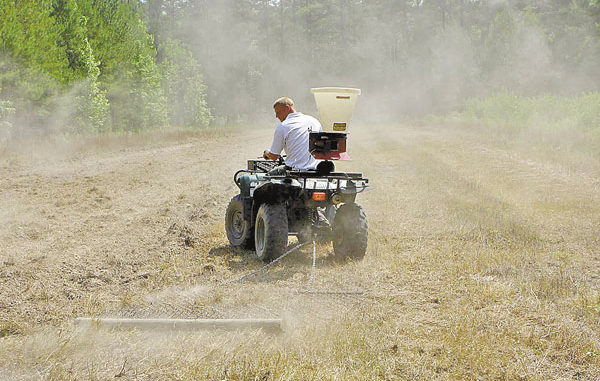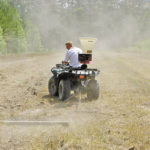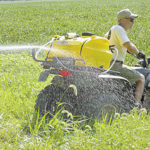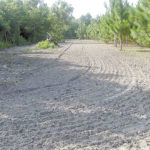
Typically, wildlife move back and forth to the best and most-available emerging food sources throughout the year. Luckily, wildlife across the Carolinas has a steady supply of agriculture crops for the taking.
Deer travel great distances to feast on the annual fall peanut, soybean, and corn crops carefully-cultivated by local farmers; wildlife are suckers for homogenized agriculture crops.
Modern agricultural practices incorporate proven methods to eliminate common issues related to cultivating crops. Wildlife food plots can be just as productive if site preparation and planting methods run parallel with the local farmer.
Bob Harkins of Major and Company in Newberry, S.C., is a biologist and food-plot expert. He carefully focuses his initial efforts on soil chemical regulation. “We have acid soils in the Southeast. For most plants to be used in wildlife openings, about 6.5 pH is ideal for plants to be able to take up the fertilizer,” he said.
Without the right nutrients and a pH-balanced environment, the future fertilizer treatment and associated seed will never get a chance to grow properly. According to Harkins, the proper pH allows plants to utilize the fertilizer, and knowing what fertilizer composition is needed to meet the needs of the crop.
“Plants can’t take up the fertilizer if the pH is too low,” said Harkins (www.majorandco.net).
As most soil types for an area can be identified on a county soil survey, the actual site may contain concentrations and/or deficiencies of certain nutrients and may have a differing level of acidity. Before supplementing the soil, a standard soil analysis is recommended to determine the soil’s actual chemical composition.
Collect several samples taken across the plot from a depth of six to eight inches, combine them into one, and mix into one sample for analysis. In South Carolina, Clemson’s Extension Services will run the analysis for $6; the North Carolina Department of Agriculture does not charge for a standard soils analysis.
“Most county extension offices offer a wildlife planting guide at minimal cost as well. It’s a great reference on fertilization and pH requirements for most plantings,” Harkins said.
In addition to fertilizer utilization, some herbicides such as triazines and sulfonylureas are affected by specific pH ranges. Specifically, their presence and effectiveness will persist within the soils longer in higher pH ranges. While remaining soil-active could further control unwanted vegetation, the herbicide may suppress the planted seed as well. Generally, prolonged soil-persistent occurs within pH ranges from 7.0 and above. Again, accurately-knowing the pH and prescribing the appropriate level of lime remains a critical component to establishing bountiful food plots. U
Kill invasive invaders
Thousands of plants thrive across the Carolinas. Since plants obtain their energy from the sun through photosynthesis, a race to proliferate and soak up the suns rays is on as soon as the sun breaks the horizon each morning. Outside forces such as wind, rain and interactions by animals disperse seeds and create opportunities for pioneering into adjacent and new areas.
Plants disperse their seeds each year, but only a fraction of these seeds germinate into new plants. Freshly-tilled or disturbed soil triggers germination of thousands of dormant seeds and sprouting of already-present root systems submerged within the soil. Food plots often result in failures from competing vegetation in this fashion. While complete eradication within food plots is almost impossible, invasive invaders can be suppressed with selective herbicides applied at the appropriate interval.
A full-spectrum herbicide treatment before planting often produces good results. While dormant seeds embedded within the soil may be less affected, the root systems of currently-established invasives can be suppressed effectively long enough to establish the targeted crop. Plant specialist Bob Harkins prefers a heavy herbicide treatment before planting.
“Weeds become a problem as soon as a plow turns the soil,” he said. “Herbicide use is almost necessary in modern agriculture and should be incorporated to yield an optimal crop in food plots.”
Harkins’ best yields result from mowing existing vegetation several weeks before spraying. He uses two quarts of Glyphosate (Round Up) per acre for most weeds but will increase the dosage when Bermuda grass and fescue are present.
“We recommend spraying the weeds just as they begin to re-sprout from mowing and plow two weeks later when all the vegetation has died,” he said.
Weeds are aggressive pioneer species and will out-compete most food-plot seed. Pretreatment of food plots is always a good plan for establishing and restarting the cool season food plot.
Fall means fall
Cool-season food plots generally fall in line with the deer season — and particularly the rut. But many land managers jump the gun and plant a little too early when conditions are less than favorable. Every hunter would like fall plots to be well established by the opening of deer season, even bow season. Some food-plot crops can be implemented early, but late-summer plantings battle with the elements typical of summer conditions. Newly-planted seeds need adequate moisture. Excessively hot days without regular rainfall causes havoc on tender sprouts, and plots soon fail afterwards.
Food-plot expert Bob Harkins prefers to plant cool-season food plots as fall conditions arrive.
“Fall means fall, not the end of summer. Many hunters who ignore the heat and plant grain and clover in late August and early September find out the hard way that nature has rules,” he said. “Many grains and clovers are susceptible to heat and plot failure.”
Conversely, food-plot seeds requiring maturation before use by wildlife must be planted early enough to mature before damaging frosts and during deer season. All crops require a certain number of days to grow and mature. If plants are planted too late, they will not mature and will fail to provide food to wildlife.
Forage crops such as clovers, brassicas, lab-lab, millet, vetch and peas offer nutrition and are palatable as soon as they emerge from the soil. These type of plantings are acceptable for later plantings if soil conditions trigger a late planting. Even peanuts can be considered a forage crop, since their greens contain nearly 20 percent protein.
Above soil chemistry and weedy competition, soil moisture is the key component for producing lush, rich food plots. Fall temperatures and decreased evapo-transpiration allows soils’ moisture content to last longer than under summertime conditions. Seeds have a coating to protect them from the outside elements. The summer heat causes problems with newly-planted seeds of any kind, with some seeds more affected than others.
“Clover is particularly susceptible to heat, and with a lack of moisture, it may cook in the field,” Harkins said.
Food plots should be planted when soils’ moisture content is consistent from frequent rainfall and decreased average daily temperature. Generally, cool-season food plots can be planted as early as mid- to late-September in most locations in the Carolinas.







Be the first to comment